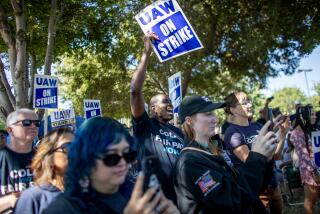2-Tier Wage Systems Not Gone, Just Less Visible
- Share via
WASHINGTON — Two-tier wage systems are disappearing from the corporate landscape. And that, says economist Richard Belous of the Conference Board, may not be as good for the average worker as it seems.
Major corporations began adopting two-tier plans in the early 1980s, cutting labor costs by setting lower pay levels for new employees and generally moving them up the wage scale more slowly than veteran workers.
Although the initial push came from the Pentagon as a way to save money in aerospace contracts, two-tier systems began spreading to other industries as the economy plunged into a recession.
The appeal to unions was simple. The plans didn’t threaten existing workers, whose wage and fringe benefits were not touched. Instead, the cuts were aimed at prospective workers who were not around to vote against the plans.
Need Remains
Over time, however, as new workers who started out on the lower rungs of the wage ladder gained the majority in plants and companies, they had the strength to abolish the systems.
But the need for continued labor savings did not disappear, and the result is a new move toward “hidden” two-tier systems, says Belous.
“I do not believe that two-tier systems are going the way of all flesh,” Belous said in a recent paper to human resource executives. “Two-tier systems will remain on the American scene. What you will start seeing are more hidden two-tier systems, low-cost subcontracting, temporaries, part-timers, leased employees and so forth.”
May Spell Trouble
There are now 30 million part-time and temporary workers, and the number is expected to grow as many employers find it cheaper to keep a slimmed-down work force, augmenting it by leasing extra help to handle peak periods of activity.
When they have to take on extra temporary help, few employers pay fringe benefits such as health insurance or pension contributions for rented workers.
Lump-sum payments such as bonuses, profit sharing and merit pay are another growing form of hidden two-tier systems that spell trouble for many workers, according to Belous. The new United Auto Worker contracts in the auto industry are a good example of what’s happening.
The contracts at Ford and General Motors call for a 3% base pay increase in the first year of the three-year contracts. The 3% is then “rolled into” the pay base for calculating fringe benefit payments. Auto workers also receive a 3% wage increase in each of the last two years of the contract. But these increases are “bonus” payments and do not become part of the wage base. The UAW is currently trying to negotiate an identical contract with Chrysler.
Humane Approach Urged
When the UAW sits down to negotiate new contracts in 1990, the starting point for wage and fringe benefit negotiations will only be 3% higher than it was in 1987 rather than 9%.
This trend, says John Zalusky of the AFL-CIO, “lowers the base rate from which one negotiates in the future. Not only do you pay for it the rest of your working life, you also pay for it in retirement.”
More to Read
Inside the business of entertainment
The Wide Shot brings you news, analysis and insights on everything from streaming wars to production — and what it all means for the future.
You may occasionally receive promotional content from the Los Angeles Times.










